If you know of a Columbia College student, faculty member, alumnus/alumna or program we should spotlight, or if you would like to submit a story, please contact:
Columbia College
Office of Communications
cc-comms@columbia.edu
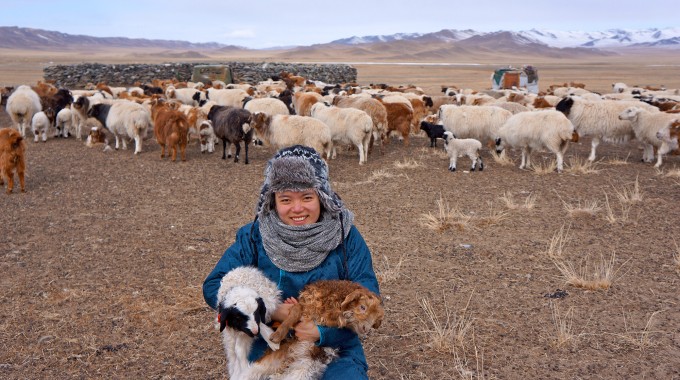
I am not wandering to get lost; I am wandering to find intimacy with a place. — Kening Zhu CC ’14
Mongolia may not seem like a conventional study abroad destination, but Kening Zhu CC ’14 made it her home during the spring 2013 semester. While on the School of International Training (SIT) Mongolia: Geopolitics and the Environment Program, she lived in a homestay in Ulaanbaatar, Mongolia’s capital, as well as with a nomadic herding family in the countryside, experiencing a life far different from her upbringing in Shanghai and North Carolina, and her time as a college student in New York. Below, the creative writing and history major traces both her journey into Mongolia’s nomadic culture and the impetus for her creation of Wandermaps, an artistic project celebrating travel that she launched upon her return to New York.
After spending four months abroad in Mongolia last spring, I visited my family in Shanghai, and then settled into a slow, simmering summer in New York City. I was living in Rockaway Park, Queens at the time, and passed most mornings walking along the beach and drawing hand-illustrated maps of my travels. I spent nights sitting in empty lifeguard chairs with ears pricked to the ocean, faintly remembering how, in Mongolia, all the lectures I attended began with the declarative statement: Mongolia, you see, is a landlocked country…
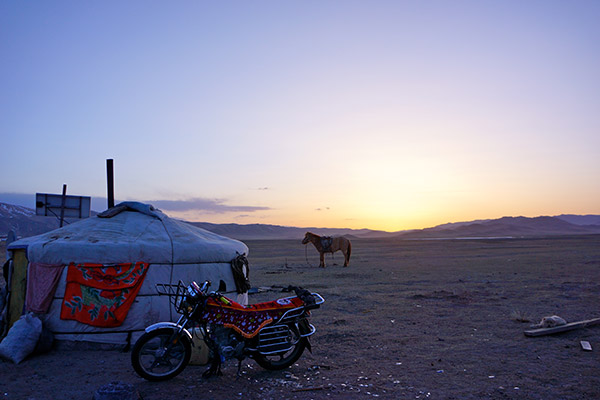 Sunset near Kening Zhu CC ’14’s host family’s ger. Photo: Kening Zhu CC ’14
Sunset near Kening Zhu CC ’14’s host family’s ger. Photo: Kening Zhu CC ’14
Because Mongolia is a landlocked country sandwiched between China and Russia, many of its 3 million people — roughly a third of the population of New York City — have never seen the sea. That summer after leaving Mongolia, I slowly aired out my suitcase and reluctantly washed the scent of sheep and goat from my winter coat and scarves, but the tangible immediacy of my time in Mongolia had already faded. I was here now, marooned on an urban beach, surrounded by saltwater and city people, with their tattoos and magazines and beer coolers. It all felt like a dream: the vast grasslands, called steppes, of the Central Asian plateau, the nomadic herders and the capital city of Ulaanbaatar. Living on the countryside inside a ger, a Mongolian felt tent, I had woken up each morning to the bleating of sheep, my host mother burning yak dung to warm the stove before milking the goats for milk tea. Ulaanbaatar — a ten-hour bus ride away — was dusty in the spring, its cracked pastel buildings and barred storefronts peeling with the remnant look of Soviet-era socialism. Nowadays, Mongolia is a young democracy. At night, young men and women drifted towards sleek nightclubs and lounges inside newly risen skyscrapers. Ger districts, shantytowns named after the felt tents of former nomadic herders who’d sold their livestock and moved for a new life in the city, layered the outskirts of Ulaanbaatar. Though to me, initially, the city felt at once haphazardly foreign and small, to a herder born and raised on the steppes, Ulaanbaatar was the ultimate Big City, a place where half of his countrymen made their homes.
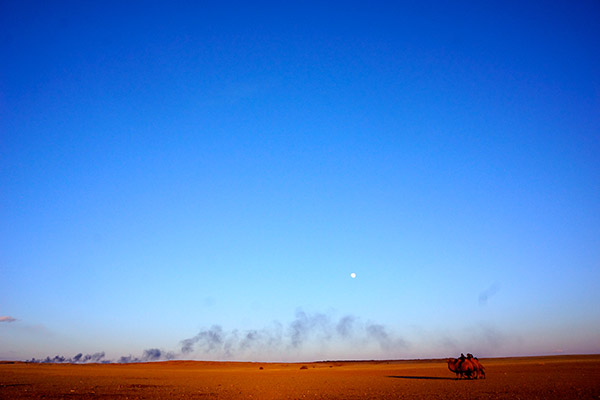 Twilght in the Gobi Desert. Photo: Dimitri Staszewski, courtesy Kening Zhu CC ’14
Twilght in the Gobi Desert. Photo: Dimitri Staszewski, courtesy Kening Zhu CC ’14
I like making maps because I think a lot about place, identity, displacement and Big Cities. I was born in China, grew up in North Carolina and have since lived four years in New York City, shuffling to Shanghai — where my parents moved after my high school graduation — over winter and summer breaks. I don’t know anyone in Shanghai. I rarely return to North Carolina, other than for friends’ weddings, and when I do, I have no home of my own to stay in. I’ve slowly forgotten much of that particular world, with its rustic southern charm, sleepy tobacco towns and magnolia trees.
My decision to study abroad was a long, arduous one, but choosing to go to Mongolia — rather than Dharamsala or Cape Town or New Delhi — came together on a whim. One day I stopped measuring the pros and cons of various programs and cities and just thought, “Mongolia.” I needed to leave New York City to know what it was like to have expansive quiet and space to breathe. I needed to leave Columbia to become intimate with an entirely different mode of learning, experiencing and being. I chose Mongolia because I thought of it as a nowhere land; my image of the country was like that of a grey, static-filled TV screen. After three years of the Core Curriculum — rigorously illuminating, deconstructing, analyzing and synthesizing knowledge — I just wanted to feel the terror of being in the dark.
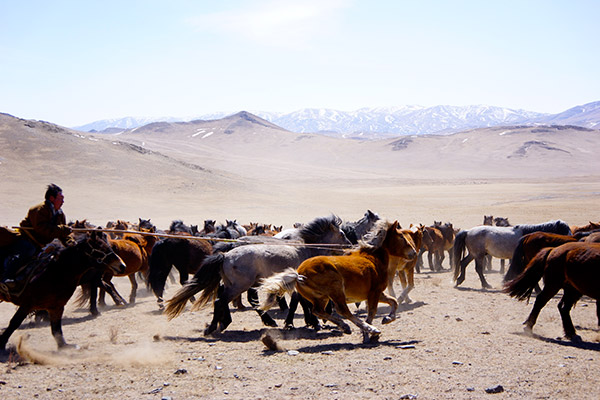 A nomadic herder "breaking," or taming, a horse. Photo: Kening Zhu CC ’14
A nomadic herder "breaking," or taming, a horse. Photo: Kening Zhu CC ’14
For Mongolians, the narrative of their country is that of one continuous thread descending from Genghis Khan’s glorious conquest of Eurasia in the thirteenth century. They are made cohesive by their nomadic tradition and sparse population, by their rootedness to the motherland, by card games everyone knows how to play and folksongs everyone knows how to sing. By the time I left, I learned to play those games and sing those songs, too — songs about mothers and horses, about steppes and rivers and mountains. Mongolians know the land intimately — even in the cities, people navigate using landmarks rather than street signs. It’s a tradition former herders brought from the countryside, where they would point and say, “to the west of that river there, to the east of those mountains.”
I’m not much of a navigator; I get lost even in the gridded streets of Manhattan. After returning from Mongolia, I started working on a map project I had put off for a long time. I thought of the process of mapmaking — making personal, hand-illustrated maps — as a way of approaching the unfamiliar. Once I’ve left a place, the maps are reminders of faraway worlds and different ways of being, a snapshot of myself in time and space. Because sometimes, immersed in the bustle of Manhattan and Columbia, it’s easy to forget.
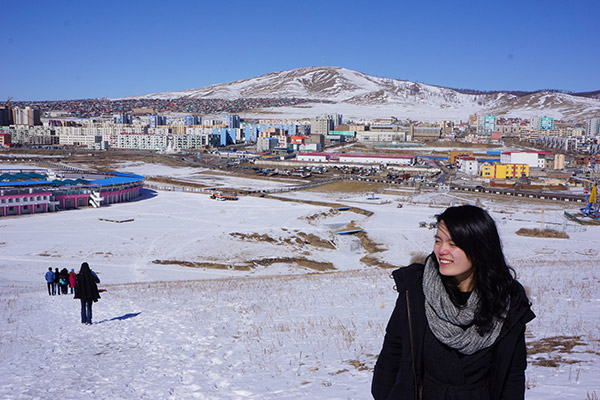 Kening Zhu CC ’14 on a trip to Erdenet — the second largest city in Mongolia — known for its mining industry. Photo: Courtesy Kening Zhu CC ’14
In high school, a close friend made me a watercolor map of our town in North Carolina, and took me on adventures to secret nooks only she knew about: a cozy cafe, a hidden pathway, a mulberry tree. After moving to New York City, I wanted to do something similar — create maps that embodied my own experiences in an alien place. During a humid summer spent in Hong Kong in 2011, bolstered by an entrepreneurially-minded friend, I started an online project for people to share maps of their own. I called it Wandermaps. We drafted wireframe sketches for the site, and thought of grand schemes for future user interface. But it was only after Mongolia — a place that initially terrified me — that, with the support of my study abroad classmates, I decided to finally launch the website.
Kening Zhu CC ’14 on a trip to Erdenet — the second largest city in Mongolia — known for its mining industry. Photo: Courtesy Kening Zhu CC ’14
In high school, a close friend made me a watercolor map of our town in North Carolina, and took me on adventures to secret nooks only she knew about: a cozy cafe, a hidden pathway, a mulberry tree. After moving to New York City, I wanted to do something similar — create maps that embodied my own experiences in an alien place. During a humid summer spent in Hong Kong in 2011, bolstered by an entrepreneurially-minded friend, I started an online project for people to share maps of their own. I called it Wandermaps. We drafted wireframe sketches for the site, and thought of grand schemes for future user interface. But it was only after Mongolia — a place that initially terrified me — that, with the support of my study abroad classmates, I decided to finally launch the website.
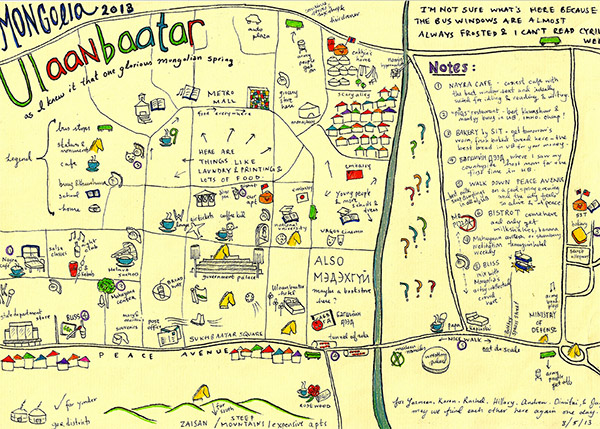 Kening Zhu CC ’14’s map of Ulaanbaatar, the capital of Mongolia.
Kening Zhu CC ’14’s map of Ulaanbaatar, the capital of Mongolia.
In June 2013, I uploaded a cursory mapmaking instruction kit to wandermaps.org, and began asking for hand-illustrated maps from friends and peers, maps that humanize cities and places through their eyes. That summer by the ocean, I made maps of Ulaanbaatar, Hong Kong and Manhattan. I am currently working on a map of New Orleans, and continually searching for other people to submit their own maps. Through Wandermaps, I hope to build a community of people invested in sharing places and experiences with each other, a community that can travel through each other’s worlds both figuratively and, perhaps one day, literally.
For me, mapmaking is one way to deal with the uncertainty inherent in the process of wandering. I am not wandering to get lost; I am wandering to find intimacy with a place. I am holding my hands out in the dark, and feeling around until I touch something special.
Learn about study abroad opportunities from the Office of Global Programs.
Learn about global internships available through the Center for Career Education.
Written by Kening Zhu CC ’14; introduction and editing by Mihika Barua CC ’15.
Kening Zhu CC ’14 is a senior studying creative writing and history. She will pursue a career in writing, while continuing to grow creative projects like Wandermaps.
Mihika Barua CC ’15, from Mumbai, is a student web editor for the Columbia College website. A political science major, she is also editor of Spectrum, the blog of the Columbia Daily Spectator.
This story appeared in the 2013–2014 Columbia College Annual Report.
Do you have a story you’d like to submit? Email columbiacollege@columbia.edu.